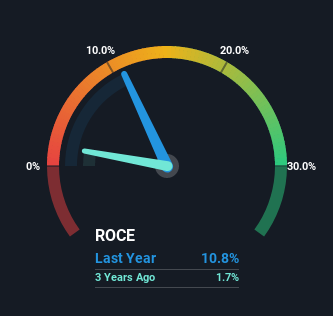- India
- /
- Construction
- /
- NSEI:BLKASHYAP
The Returns At B.L. Kashyap and Sons (NSE:BLKASHYAP) Aren't Growing
Did you know there are some financial metrics that can provide clues of a potential multi-bagger? In a perfect world, we'd like to see a company investing more capital into its business and ideally the returns earned from that capital are also increasing. This shows us that it's a compounding machine, able to continually reinvest its earnings back into the business and generate higher returns. In light of that, when we looked at B.L. Kashyap and Sons (NSE:BLKASHYAP) and its ROCE trend, we weren't exactly thrilled.
Understanding Return On Capital Employed (ROCE)
Just to clarify if you're unsure, ROCE is a metric for evaluating how much pre-tax income (in percentage terms) a company earns on the capital invested in its business. To calculate this metric for B.L. Kashyap and Sons, this is the formula:
Return on Capital Employed = Earnings Before Interest and Tax (EBIT) ÷ (Total Assets - Current Liabilities)
0.11 = ₹695m ÷ (₹15b - ₹8.1b) (Based on the trailing twelve months to December 2022).
Therefore, B.L. Kashyap and Sons has an ROCE of 11%. In absolute terms, that's a pretty normal return, and it's somewhat close to the Construction industry average of 12%.
View our latest analysis for B.L. Kashyap and Sons

Historical performance is a great place to start when researching a stock so above you can see the gauge for B.L. Kashyap and Sons' ROCE against it's prior returns. If you want to delve into the historical earnings, revenue and cash flow of B.L. Kashyap and Sons, check out these free graphs here.
The Trend Of ROCE
Things have been pretty stable at B.L. Kashyap and Sons, with its capital employed and returns on that capital staying somewhat the same for the last five years. Businesses with these traits tend to be mature and steady operations because they're past the growth phase. So don't be surprised if B.L. Kashyap and Sons doesn't end up being a multi-bagger in a few years time.
On a separate but related note, it's important to know that B.L. Kashyap and Sons has a current liabilities to total assets ratio of 56%, which we'd consider pretty high. This effectively means that suppliers (or short-term creditors) are funding a large portion of the business, so just be aware that this can introduce some elements of risk. Ideally we'd like to see this reduce as that would mean fewer obligations bearing risks.
The Key Takeaway
We can conclude that in regards to B.L. Kashyap and Sons' returns on capital employed and the trends, there isn't much change to report on. Since the stock has declined 23% over the last five years, investors may not be too optimistic on this trend improving either. All in all, the inherent trends aren't typical of multi-baggers, so if that's what you're after, we think you might have more luck elsewhere.
On a final note, we found 3 warning signs for B.L. Kashyap and Sons (1 makes us a bit uncomfortable) you should be aware of.
While B.L. Kashyap and Sons isn't earning the highest return, check out this free list of companies that are earning high returns on equity with solid balance sheets.
The New Payments ETF Is Live on NASDAQ:
Money is moving to real-time rails, and a newly listed ETF now gives investors direct exposure. Fast settlement. Institutional custody. Simple access.
Explore how this launch could reshape portfolios
Sponsored ContentValuation is complex, but we're here to simplify it.
Discover if B.L. Kashyap and Sons might be undervalued or overvalued with our detailed analysis, featuring fair value estimates, potential risks, dividends, insider trades, and its financial condition.
Access Free AnalysisHave feedback on this article? Concerned about the content? Get in touch with us directly. Alternatively, email editorial-team (at) simplywallst.com.
This article by Simply Wall St is general in nature. We provide commentary based on historical data and analyst forecasts only using an unbiased methodology and our articles are not intended to be financial advice. It does not constitute a recommendation to buy or sell any stock, and does not take account of your objectives, or your financial situation. We aim to bring you long-term focused analysis driven by fundamental data. Note that our analysis may not factor in the latest price-sensitive company announcements or qualitative material. Simply Wall St has no position in any stocks mentioned.
About NSEI:BLKASHYAP
B.L. Kashyap and Sons
Engages in the construction and infrastructure development activities in India.
Mediocre balance sheet with low risk.
Similar Companies
Market Insights
Weekly Picks

THE KINGDOM OF BROWN GOODS: WHY MGPI IS BEING CRUSHED BY INVENTORY & PRIMED FOR RESURRECTION


Why Vertical Aerospace (NYSE: EVTL) is Worth Possibly Over 13x its Current Price


The Quiet Giant That Became AI’s Power Grid
Recently Updated Narratives


A tech powerhouse quietly powering the world’s AI infrastructure.


Keppel DC REIT (SGX: AJBU) is a resilient gem in the data center space.


Why Vertical Aerospace (NYSE: EVTL) is Worth Possibly Over 13x its Current Price
Popular Narratives


MicroVision will explode future revenue by 380.37% with a vision towards success


Crazy Undervalued 42 Baggers Silver Play (Active & Running Mine)






